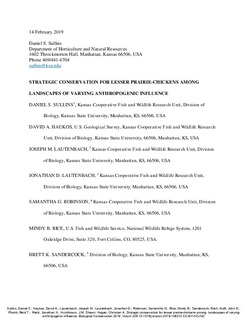Strategic conservation for lesser prairie-chickens among landscapes of varying anthropogenic influence
Sullins, Daniel S.; Haukos, David A.; Lautenbach, Joseph M.; Lautenbach, Jonathan D.; Robinson, Samantha G.; Rice, Mindy B.; Sandercock, Brett; Kraft, John D.; Plumb, Reid T.; Reitz, Jonathan H.; Hutchinson, J.M. Shawn; Hagen, Christian A.
Journal article
Accepted version

Åpne
Permanent lenke
http://hdl.handle.net/11250/2612547Utgivelsesdato
2019Metadata
Vis full innførselSamlinger
- Scientific publications [1392]
Originalversjon
10.1016/j.biocon.2019.108213Sammendrag
For millennia grasslands have provided a myriad of ecosystem services and have been coupled with human resource use. The loss of 46% of grasslands worldwide necessitates the need for conservation that is spatially, temporally, and socioeconomically strategic. In the Southern Great Plains of the United States, conversion of native grasslands to cropland, woody encroachment, and establishment of vertical anthropogenic features have made large intact grasslands rare for lesser prairie-chickens (Tympanuchus pallidicinctus). However, it remains unclear how the spatial distribution of grasslands and anthropogenic features constrain populations and influence conservation. We estimated the distribution of lesser prairie-chickens using data from individuals marked with GPS transmitters in Kansas and Colorado, USA, and empirically derived relationships with anthropogenic structure densities and grassland composition. Our model suggested decreased probability of use in 2-km radius (12.6 km2) landscapes that had greater than two vertical features, two oil wells, 8 km of county roads, and 0.15 km of major roads or transmission lines. Predicted probability of use was greatest in 5-km radius landscapes that were 77% grassland. Based on our model predictions, ~10% of the current expected lesser prairie-chicken distribution was available as habitat. We used our estimated species distribution to provide spatially explicit
prescriptions for CRP enrollment and tree removal in locations most likely to benefit lesser prairie-chickens.
Spatially incentivized CRP sign up has the potential to provide 4189 km2 of additional habitat and Strategic application of tree removal has the potential to restore 1154 km2. Tree removal and CRP enrollment are Conservation tools that can align with landowner goals and are much more likely to be effective on privately owned working lands.
